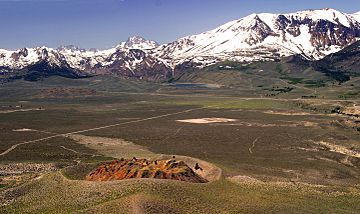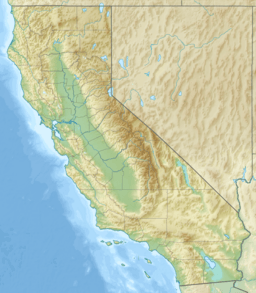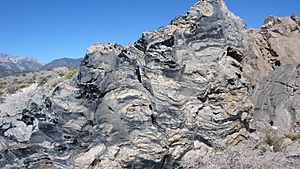Panum Crater facts for kids
Quick facts for kids Panum Crater |
|
|---|---|

Panum Crater at the foot of the Sierra Nevada
|
|
| Highest point | |
| Elevation | 7045+ ft (2147+ m) NAVD 88 |
| Prominence | 220 ft (67 m) |
| Listing | Great Basin Peaks List |
| Geography | |
| Location | Mono County, California |
| Parent range | Mono–Inyo Craters |
| Topo map | USGS Lee Vining |
| Geology | |
| Mountain type | Rhyolite lava dome |
| Volcanic field | Long Valley Caldera Field |
| Last eruption | 1325-1365 CE |
Panum Crater is a volcano in California, United States. It is part of the Mono–Inyo Craters, which is a chain of volcanoes. Panum Crater is located south of Mono Lake and east of the Sierra Nevada mountains. This volcano is quite young, forming about 600 to 700 years ago. It is a great example of a rhyolite lava dome.
Contents
What is Rhyolite Lava?
Rhyolite volcanoes have lava with a lot of a material called silica. At Panum Crater, about 76 percent of the lava is silica. This makes the lava very thick, or viscous. It also makes the lava look very glassy.
When a rhyolite volcano erupts, it can produce two main things:
- Pumice: This is a light, bubbly rock. It forms when gas escapes from the lava.
- Obsidian: This is a dark, smooth volcanic glass. Native Americans used obsidian to make sharp tools like arrow points and scrapers.
How Panum Crater Formed
Panum Crater was created in a series of exciting steps.
First Eruption: Steam Explosion
The first thing that happened was hot, melted rock, called magma, rose from deep inside the Earth. When this super hot magma touched water just below the surface, the water quickly turned into steam. This caused a huge, powerful explosion! The steam blasted old dirt and rocks from the lake bottom into the air. This material fell back down, forming small mounds around the new opening, called a vent. So much material was blown out that a big hole, or crater, was left behind.
Second Eruption: Cinder Cone
After the first explosion, a fountain of small, bubbly rocks called cinders shot high into the sky. As this huge amount of ash and pumice fell back to Earth, it built up a ring around the original vent. This ring formed a small, cone-shaped hill, known as a cinder cone. You can still see this cinder cone today.
Third Eruption: Lava Domes
After the violent explosions, the thick magma slowly pushed its way to the surface. It formed a series of rounded hills called domes. Each dome started when the thick, rhyolite lava flowed out and then hardened. This hard lava created a cap over the vent.
As more magma pushed up from below, the hard cap (or dome) would crack and break apart. These broken pieces would then fall down the sides of the newly forming dome. This process happened many times. A new mountain was built from these broken pieces, which geologists call crumble breccia. The mountain kept growing this way until the force inside the volcano became weaker. No more new domes formed after that. The very last dome is the one you see standing today.
Final Stage: Spire Building
As the final dome cooled and hardened, something interesting happened. Thick lava pushed up through cracks in the cooling dome. This created tall, castle-like shapes called spires. Imagine squeezing toothpaste out of a tube; it forms a small tower before it might fall over. Most of the spires at Panum Crater fell over and broke. This happened because they cooled very quickly, and there were also small explosions at their bases. Much of the rocky debris you see at the top of the dome today is what's left of these crumbled spires.
Inside the Lava Dome
The main lava dome at Panum Crater is made of both pumice and obsidian. They are made of the same material, but they look different because of how gas escaped as the magma cooled.
Think of it like a bottle of fizzy soda. The magma that formed the dome had gas dissolved in it, just like the bubbles in soda. As the magma rose closer to the surface, there was less pressure on it. This allowed the gas to expand, creating the holes and bubbles you see in pumice.
However, some of the magma stayed under pressure as it cooled quickly. Or, it might have already lost its gas. This magma formed the smooth, dark obsidian.
You can often see both obsidian and pumice together in patterns called flow banding at Panum Crater. Another common texture you might see is called breadcrust. This forms when the inside of a cooling rock is still hot and gas is escaping, but the outside surface has already cooled. As the gas expands from the inside, the cool outer surface cracks to let the gas out, making it look like the crust of a loaf of bread.]



